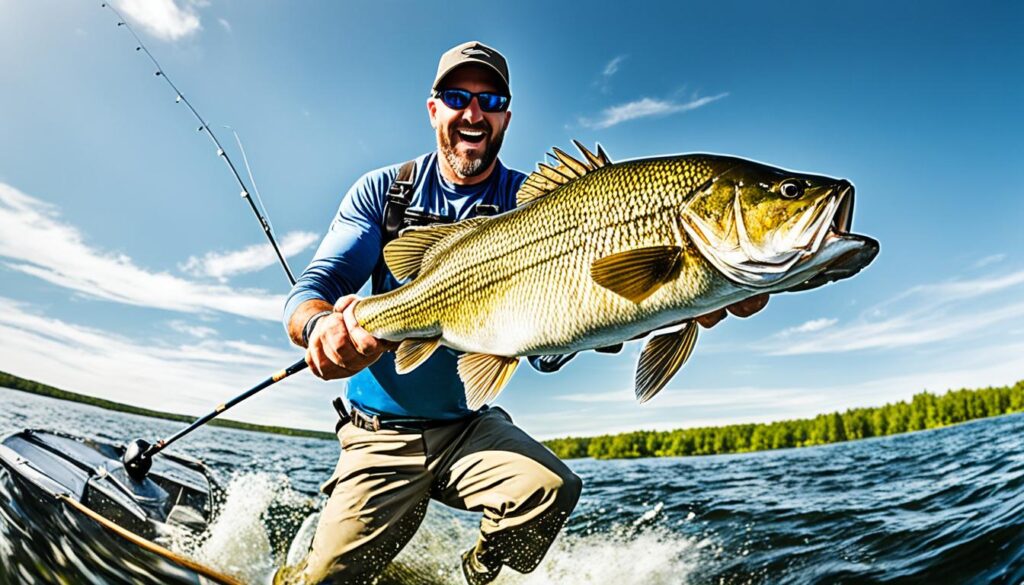The smallmouth bass (Micropterus dolomieu) is a popular freshwater game fish belonging to the sunfish family (Centrarchidae) in the order Perciformes. As the type species of its genus Micropterus (black basses), it’s a popular target among anglers throughout the temperate zones of North America.
Distribution and Size
Found in the upper and middle Mississippi River basin, the Saint Lawrence River–Great Lakes system, the Champlain Valley, and the Hudson Bay basin, the smallmouth bass has also been introduced to various cool-water tributaries and lakes in Canada and the United States through stocking and illegal introductions. These fish can reach an impressive maximum recorded size of approximately 27 inches (69 cm) and 12 pounds (5.4 kg).
Popular Nicknames
Anglers affectionately refer to the smallmouth bass by several common names, including smallmouth, bronzeback, brown bass, brownie, smallie, bronze bass, and bareback bass.
Smallmouth Bass Fishing: A Strategic Pursuit
Smallmouth bass fishing combines strategy and skill, requiring anglers to adapt to different conditions and employ specialized techniques. Whether you’re a seasoned angler or new to the sport, the following insights can enhance your smallmouth bass fishing outings and improve your chances of landing that trophy catch.
Angler’s Essentials:
- Smallmouth bass fishing offers a thrilling angling experience
- Adapting techniques to specific conditions is critical for successful smallmouth bass fishing
- Preserving the smallmouth bass population through catch-and-release is essential
- Proven techniques and hotspots can significantly enhance your chances of success
- Exploring renowned lakes, rivers, and reservoirs is the key to finding abundant populations of smallmouth bass
Techniques for Smallmouth Bass Fishing
In smallmouth bass fishing, mastering the proper techniques can make all the difference in your angling success. From selecting the correct tackle to honing your casting skills, understanding the various methods involved will help maximize your chances of landing that trophy smallmouth bass.
Casting Techniques:
- Long-distance casting: To achieve greater distance and accuracy, combine an overhead cast with a sidearm motion.
- Pitching: This technique involves flipping your lure or bait into target areas close to cover or structure. It’s an excellent option for fishing in tight spaces.
- Skip Casting: By skimming your bait or lure across the water’s surface, you can effectively target hard-to-reach areas like docks or overhanging vegetation where smallmouth bass often hide.
Lure Selection:
- Topwater Lures: Create surface commotion to entice smallmouth bass into striking. Experiment with buzzbaits, poppers, and walking baits for an exciting visual experience.
- Jerkbaits: Designed to imitate injured baitfish, jerkbaits can be worked by twitching and pausing the action to trigger aggressive strikes.
- Soft Plastics: Versatile and practical, soft plastic baits like tubes, worms, and creatures can be rigged in various ways to mimic crawfish, baitfish, or other natural prey.
Tackle Selection:
- Rods: Choose a medium to medium-heavy spinning or casting rod in the 6 to 7-foot range to provide the right balance of sensitivity and power.
- Reels: Opt for a high-quality reel with a smooth drag system and a gear ratio suitable for different presentations.
- Line: Use fluorocarbon or braided line for better sensitivity and improved hooksets, especially when fishing in clear water or around heavy cover.
Proven Techniques:
- Drag and Pause: After casting your lure, let it sink to the desired depth and then retrieve it slowly with intermittent pauses to imitate injured or dying prey.
- Drop-shotting: Rig a finesse-style worm or bait on a drop-shot rig, keeping it just above the bottom and enticing smallmouth bass with subtle movements.
- Swimming Retrieve: Retrieve your bait or lure steadily at or just below the water’s surface, mimicking the movement of a swimming baitfish.
Remember, smallmouth bass behavior can vary based on weather, time of year, and water conditions. Be adaptable and experiment with different techniques to find what works best in your fishing location.

Tackle Tips: Choosing the Right Fishing Line
Finding the right fishing line is crucial for smallmouth bass fishing success. Consider the following:
Fluorocarbon Line: Known for its low visibility and excellent sensitivity, it is popular among anglers targeting smallmouth bass in clear water conditions.
Braided Line: With superior strength and abrasion resistance, braided line is ideal for fishing around heavy cover or targeting giant smallmouth bass. To reduce line visibility, could you consider using a fluorocarbon leader?
Monofilament Line: Versatile and budget-friendly, the monofilament line offers good knot strength and is suitable for various smallmouth bass fishing techniques. However, it can stretch, reducing sensitivity.
Hotspots for Smallmouth Bass Fishing
Expanding on the techniques discussed in the previous section, let’s explore some of the best smallmouth bass fishing spots across the United States. These iconic locations are renowned among anglers for their abundant populations of smallmouth bass and consistently producing trophy catches. Whether you are a beginner or an experienced angler, these hotspots offer incredible opportunities to test your skills and reel in some impressive smallmouth bass.
Lakes
Lakes are often the top choice for many anglers when it comes to smallmouth bass fishing. The expansive waters allow the bass to thrive and grow to impressive sizes. Here are some of the best smallmouth bass fishing lakes in the United States:
- Lake Erie, Pennsylvania
- Lake St. Clair, Michigan
- Champlain Lake, New York/Vermont
Rivers
Rivers are another fantastic option for smallmouth bass fishing, offering dynamic and ever-changing conditions that can challenge even the most skilled anglers. Here are some of the top river destinations for smallmouth bass fishing:
- James River, Virginia
- New River, West Virginia/North Carolina/Virginia
- Mississippi River, Minnesota/Wisconsin
Reservoirs
Reservoirs are artificial bodies of water that provide excellent opportunities for smallmouth bass fishing. Due to their ideal habitat conditions, these productive ecosystems often harbor large smallmouth bass populations. Here are a few notable reservoirs for smallmouth bass fishing:
- Table Rock Lake, Missouri
- Dale Hollow Lake, Kentucky/Tennessee
- Chequamegon Bay, Lake Superior, Wisconsin
Remember, these are just a few examples of the best smallmouth bass fishing spots in the United States. Numerous other hidden gems are waiting to be discovered. Before planning your fishing trip, it’s always a good idea to check local regulations and conditions to ensure the best experience.
“The thrill of hooking into a smallmouth bass in one of these hotspots is unlike anything else. You never know when you’ll feel that powerful tug on your line, and the adrenaline rush that follows is truly addictive.” – Experienced Angler.

Conclusion
In conclusion, smallmouth bass fishing provides an exhilarating angling experience for any passionate fisherman. By incorporating the techniques and exploring the hotspots shared in this article, you can greatly increase your chances of success on the water.
Remember to adapt your fishing techniques to the specific conditions of each fishing trip, as smallmouth bass behavior can vary depending on factors such as weather, water temperature, and time of year. Smallmouth bass fishing tips can be found in various resources, including online forums, fishing guides, and local angler communities.
Furthermore, it is vital to practice catch-and-release when targeting smallmouth bass. By releasing the fish you catch, you contribute to the preservation of this magnificent game fish for future generations of anglers. This practice ensures the sustainability and longevity of smallmouth bass populations, allowing more enthusiasts to enjoy the thrill of game fish angling for years to come.
So grab your fishing gear, head to the hotspots mentioned earlier, and put your newfound knowledge into action. With patience, skill, and a bit of luck, you’ll be rewarded with unforgettable smallmouth bass fishing experiences. Happy fishing!
FAQ
What is smallmouth bass fishing?
Smallmouth bass fishing is the activity of targeting and catching smallmouth bass, a popular game fish found in various bodies of water across the United States.
Where can I find smallmouth bass?
Smallmouth bass can be found in lakes, rivers, and reservoirs throughout the United States. Some popular smallmouth bass fishing locations include Lake Erie, the St. Lawrence River, and the Tennessee River.
What techniques should I use for smallmouth bass fishing?
When fishing for smallmouth bass, it is recommended to use a variety of techniques such as topwater fishing, crankbait fishing, and finesse fishing with soft plastics. Experimenting with different techniques can help you figure out what works best for the specific conditions you are fishing in.
What kind of tackle should I use for smallmouth bass fishing?
For smallmouth bass fishing, it is recommended to use medium to medium-heavy spinning or baitcasting rods with fast or extra-fast action. Pairing these rods with 8-10 pound test monofilament or fluorocarbon line is usually sufficient for most smallmouth bass fishing situations.
What are some hotspots for smallmouth bass fishing?
Some popular hotspots for smallmouth bass fishing include Lake Champlain in Vermont, the Susquehanna River in Pennsylvania, and Table Rock Lake in Missouri. These locations are known for their abundant populations of smallmouth bass and offer great opportunities for anglers.
Are there any special regulations for smallmouth bass fishing?
Fishing regulations for smallmouth bass vary by location, so it is important to check the specific regulations for the body of water you plan to fish. Some common regulations include size limits, creel limits, and seasonal restrictions.
